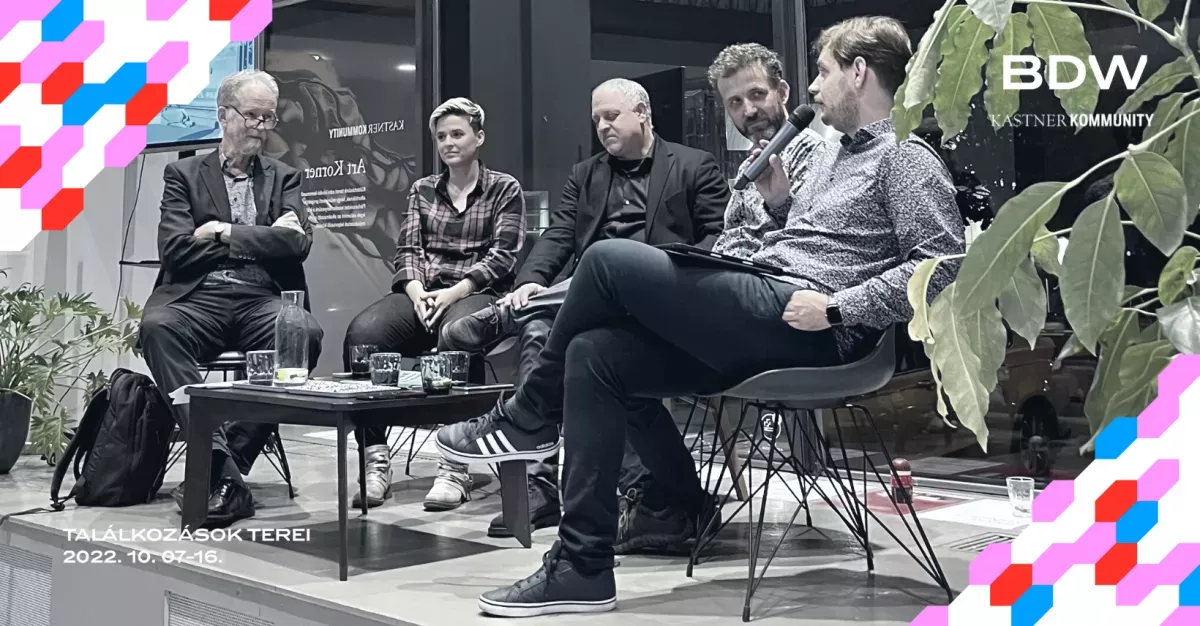"There will be terrible ads as long as there are this many surfaces available"
The main issue with giant advertising meshes and banners is the lack of enforcement and adherence to regulations, as revealed during a discussion on advertising and architecture at Kastner Kommunity. No real qualitative change can be expected as long as such a vast number of advertising surfaces are available so cheaply in Hungary. But will there be any change to the cityscape, and could the spread of digital advertising surfaces offer a solution?
"It’s extremely uncomfortable when a city sends the message that everything is for sale. That’s a very bad message about the city,”
– said Zoltán Erő, Chief Architect of Budapest, setting the tone for the panel discussion held during Budapest Design Week on building wraps and advertising. The roundtable took place at Kastner Kommunity, moderated by journalist Miklós Vincze from 24.hu, and featured Zoltán Erő, Andrea Tóth (Managing and Creative Director at Kastner), Bálint Hantosi (Chair of the OOH section of the Hungarian Advertising Association), and architectural writer Dávid Zubreczki, sharing their views on the state of urban advertising surfaces.
As if running a red light had no consequences
The roundtable was prompted by a decision announced earlier this spring by the Budapest municipality, which we at Kreatív have covered multiple times. Mayor Gergely Karácsony’s administration aims to fight the proliferation of building meshes and stretched banners through stricter regulations on public space usage.
Zoltán Erő, who previously shared his opinion with Kreatív, mentioned during the panel that some enforcement actions are already underway since the new rules took effect. However, the discussion made it clear that the problem is far from solved.
According to Bálint Hantosi, the core issue lies in the failure to enforce existing regulations—those that were already in place before the city tightened its stance. Representing the Advertising Association, Hantosi said the current situation is like a scenario where running a red light has no consequences.
He pointed out that, according to the 2017 Urban Image Act, advertisements on building meshes should not exceed 9 square meters, and stretched banners are entirely prohibited. But in reality, this is not the case, due to the lack of penalties. Supporting this, Zoltán Erő gave examples of facade advertisements in the city center where it’s clear that no construction is taking place behind the mesh.
 Participants of the discussion (from left): Zoltán Erő, Andrea Tóth, Bálint Hantosi, Dávid Zubreczki, and Miklós Vincze
Participants of the discussion (from left): Zoltán Erő, Andrea Tóth, Bálint Hantosi, Dávid Zubreczki, and Miklós Vincze
"Since 2017, the Urban Image Act has prohibited the installation of new billboards in Hungary—and yet, more than 4,000 have been installed nationwide since then. I see the solution in enforcing the laws that already exist. We've offered our support to the Advertising Association multiple times. But what I see is that dealing with this issue is such a hassle that no one wants to take responsibility. There are 54,000 billboard and citylight surfaces in Hungary today. I believe we don’t need more than 30,000,”
– said the OOH section president, who also noted that one cannot ignore the fact that residential buildings benefit financially from selling these advertising spaces.
Hantosi added that he expects major changes within three years, based on his sense that decision-makers are beginning to seriously consider resolving the issue. This would require enforceable regulations developed in consultation with professionals. Beyond national legislation, local governments can implement even stricter rules. Hantosi cited existing solutions in some Hungarian cities where outdoor advertising is either completely banned or only allowed under strict conditions in protected urban areas.
If ad space were expensive, advertisers and agencies would put in more effort
The roundtable also addressed why giant advertisements are so divisive in the context of urban aesthetics—often, it’s because their quality is low and visually offensive.
The panelists believe this stems from how cheap outdoor advertising surfaces are in Hungary. This means creative agencies and advertisers aren’t incentivized to produce high-quality work. Andrea Tóth noted another issue: creative agencies are often informed at the last minute that a media agency has acquired outdoor space for the campaign, leading to poorly thought-out or misplaced ads.
"There will be terrible ads as long as there are this many surfaces,”
– summarized Hantosi, who argued that cheap ad space allows even niche products to appear on TV, radio, and in public spaces—places where they don’t belong. He believes that Hungary should immediately eliminate at least 15,000 public advertising spaces in order to see any improvement in quality.
Airports, for instance, offer higher-quality advertising because "the surfaces are extremely expensive," noted the panelists. In contrast, in cities, a supermarket can easily change its ad weekly with pictures and prices of current promotions.
Opinions were divided on whether the spread of digital advertising surfaces could improve the situation. Andrea Tóth believes that new technology has already introduced more creative and better-quality options in the Hungarian market. However, Bálint Hantosi is more skeptical, citing cost as a major limiting factor.
"Installing a billboard surface costs about 500,000 to 600,000 forints and can be used for 20 years with minimal maintenance. In contrast, a digital advertising surface costs 10 million forints and lasts only 3 years. That makes the return on investment significantly more demanding in the case of digital screens,”
– Hantosi explained.




